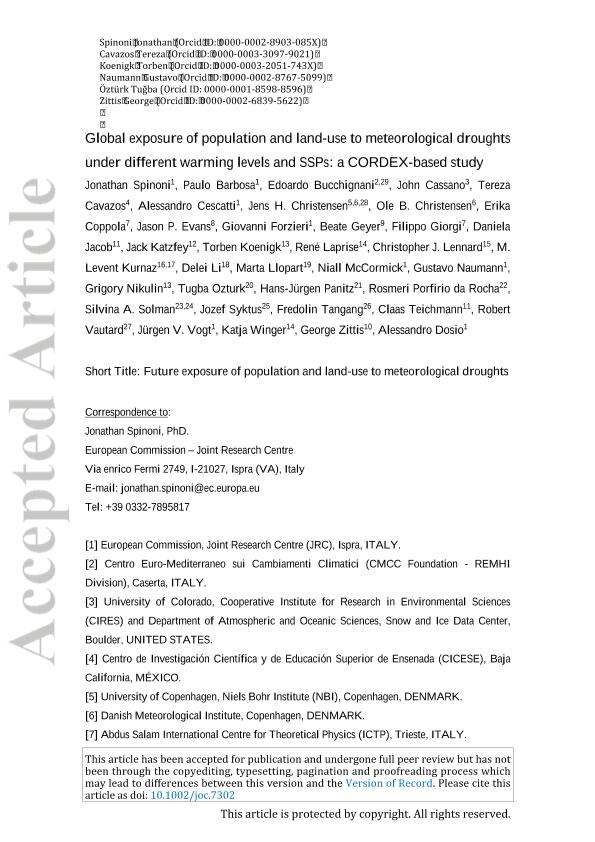Artículo
Global exposure of population and land-use to meteorological droughts under different warming levels and SSPs: A CORDEX-based study
Spinoni, Jonathan; Barbosa, Paulo; Bucchignani, Edoardo; Cassano, John; Cavazos, Tereza; Cescatti, Alessandro; Christensen, Jens H.; Christensen, Ole; Coppola, Erika; Evans, Jason P.; Forzieri, Giovanni; Geyer, Beate; Giorgi, Filippo; Jacob, Daniela; Katzfey, Jack; Koenigk, Torben; Laprise, René; Lennard, Christopher J.; Kurnaz, M. Levent; Li, Delei; Llopart, Marta; McCormick, Niall; Naumann, Gustavo ; Nikulin, Grigory; Ozturk, Tugba; Panitz, Hans-Jürgen; Rocha, Rosmeri Porfirio; Solman, Silvina Alicia
; Nikulin, Grigory; Ozturk, Tugba; Panitz, Hans-Jürgen; Rocha, Rosmeri Porfirio; Solman, Silvina Alicia ; Syktus, Jozef; Tangang, Fredolin; Teichmann, Claas; Vautard, Robert; Vogt, Jürgen V.; Winger, Katja; Zittis, George; Dosio, Alessandro
; Syktus, Jozef; Tangang, Fredolin; Teichmann, Claas; Vautard, Robert; Vogt, Jürgen V.; Winger, Katja; Zittis, George; Dosio, Alessandro
 ; Nikulin, Grigory; Ozturk, Tugba; Panitz, Hans-Jürgen; Rocha, Rosmeri Porfirio; Solman, Silvina Alicia
; Nikulin, Grigory; Ozturk, Tugba; Panitz, Hans-Jürgen; Rocha, Rosmeri Porfirio; Solman, Silvina Alicia ; Syktus, Jozef; Tangang, Fredolin; Teichmann, Claas; Vautard, Robert; Vogt, Jürgen V.; Winger, Katja; Zittis, George; Dosio, Alessandro
; Syktus, Jozef; Tangang, Fredolin; Teichmann, Claas; Vautard, Robert; Vogt, Jürgen V.; Winger, Katja; Zittis, George; Dosio, Alessandro
Fecha de publicación:
07/2021
Editorial:
John Wiley & Sons Ltd
Revista:
International Journal of Climatology
ISSN:
0899-8418
Idioma:
Inglés
Tipo de recurso:
Artículo publicado
Clasificación temática:
Resumen
Global warming is likely to cause a progressive drought increase in some regions, but how population and natural resources will be affected is still underexplored. This study focuses on global population, forests, croplands and pastures exposure to meteorological drought hazard in the 21st century, expressed as frequency and severity of drought events. As input, we use a large ensemble of climate simulations from the Coordinated Regional Climate Downscaling Experiment (CORDEX), population projections from the NASA-SEDAC dataset and land-use projections from the Land-Use Harmonization 2 project for 1981–2100. The exposure to drought hazard is presented for five Shared Socioeconomic Pathways (SSP1-SSP5) at four Global Warming Levels (GWLs: 1.5°C to 4°C). Results show that considering only Standardized Precipitation Index (SPI; based on precipitation), the SSP3 at GWL4 projects the largest fraction of the global population (14%) to experience an increase in drought frequency and severity (versus 1981–2010), with this value increasing to 60% if temperature is considered (indirectly included in the Standardized Precipitation-Evapotranspiration Index, SPEI). With SPEI, considering the highest GWL for each SSP, 8 (for SSP2, SSP4, SSP5) and 11 (SSP3) billion people, that is, more than 90%, will be affected by at least one unprecedented drought. For SSP5 at GWL4, approximately 2 × 106 km2 of forests and croplands (respectively, 6% and 11%) and 1.5 × 106 km2 of pastures (19%) will be exposed to increased drought frequency and severity according to SPI, but for SPEI this extent will rise to 17 × 106 km2 of forests (49%), 6 × 106 km2 of pastures (78%) and 12 × 106 km2 of croplands (67%), being mid-latitudes the most affected. The projected likely increase of drought frequency and severity significantly increases population and land-use exposure to drought, even at low GWLs, thus extensive mitigation and adaptation efforts are needed to avoid the most severe impacts of climate change.
Archivos asociados
Licencia
Identificadores
Colecciones
Articulos(CIMA)
Articulos de CENTRO DE INVESTIGACIONES DEL MAR Y LA ATMOSFERA
Articulos de CENTRO DE INVESTIGACIONES DEL MAR Y LA ATMOSFERA
Citación
Spinoni, Jonathan; Barbosa, Paulo; Bucchignani, Edoardo; Cassano, John; Cavazos, Tereza; et al.; Global exposure of population and land-use to meteorological droughts under different warming levels and SSPs: A CORDEX-based study; John Wiley & Sons Ltd; International Journal of Climatology; 41; 15; 7-2021; 6825-6853
Compartir
Altmétricas



